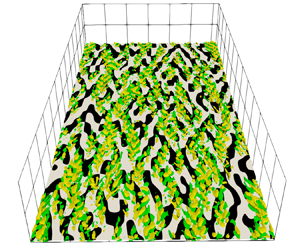Article contents
Nonlinear optimal perturbation of turbulent channel flow as a precursor of extreme events
Published online by Cambridge University Press: 29 August 2023
Abstract

This work aims at studying the mechanisms behind the occurrence of extreme dissipation events in a channel flow, identifying nonlinear optimal perturbations as potential precursors of these events. Nonlinear optimal perturbations with respect to a generic turbulent instantaneous snapshot are computed for the first time using a direct-adjoint algorithm in the channel flow at  $Re_{\tau }\approx 180$. The resulting initial perturbation displays the upstream tilting characteristic of Orr's mechanism and is positioned along the interfaces between two opposite-sign velocity streaks of the pre-existing turbulent field. Such a perturbation induces a sudden breakdown of the pre-existing structures and a heavier tail in the dissipation probability density function distribution. Different mechanisms are at play during this process: the high shear present at the interface between coherent low- and high-momentum regions is exploited to break down the larger structures and drive energy to small scales. This energy cascade is fed by an enhanced lift-up effect that produces intense streaks near the wall. It is found that the optimal perturbation grows exponentially during the first phase of its evolution reflecting the existence of a secondary modal instability of the streaks. To corroborate the results, the conditional spatiotemporal proper orthogonal decomposition (POD) analysis of Hack & Schimdt (J. Fluid Mech., vol. 907, 2021, A9) is performed both in the perturbed and in the unperturbed flow, showing a clear agreement between the two cases and with the reference study. Thus, the optimal perturbation at initial time can be considered as a precursor of extreme events.
$Re_{\tau }\approx 180$. The resulting initial perturbation displays the upstream tilting characteristic of Orr's mechanism and is positioned along the interfaces between two opposite-sign velocity streaks of the pre-existing turbulent field. Such a perturbation induces a sudden breakdown of the pre-existing structures and a heavier tail in the dissipation probability density function distribution. Different mechanisms are at play during this process: the high shear present at the interface between coherent low- and high-momentum regions is exploited to break down the larger structures and drive energy to small scales. This energy cascade is fed by an enhanced lift-up effect that produces intense streaks near the wall. It is found that the optimal perturbation grows exponentially during the first phase of its evolution reflecting the existence of a secondary modal instability of the streaks. To corroborate the results, the conditional spatiotemporal proper orthogonal decomposition (POD) analysis of Hack & Schimdt (J. Fluid Mech., vol. 907, 2021, A9) is performed both in the perturbed and in the unperturbed flow, showing a clear agreement between the two cases and with the reference study. Thus, the optimal perturbation at initial time can be considered as a precursor of extreme events.
JFM classification
- Type
- JFM Papers
- Information
- Copyright
- © The Author(s), 2023. Published by Cambridge University Press
References
- 3
- Cited by



